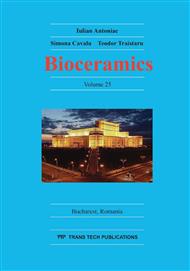[1]
S. Dorozhkin, Biphasic, triphasic and multiphasic calcium orthophosphates. Acta Biomaterialia. (2012) 963-977.
DOI: 10.1016/j.actbio.2011.09.003
Google Scholar
[2]
O. Malard, H. Gautier , G. Daculsi, In Vivo Demonstration of 2 Types of Microporosity on the Kinetic of Bone Ingrowth and Biphasic Calcium Phosphate Bioceramics Resorption Key Engineering Materials. 1233(2007) 361-363.
DOI: 10.4028/www.scientific.net/kem.361-363.1233
Google Scholar
[3]
R.Z. LeGeros, S. Lin, R. Rohanizadeh, D. Mijares, J.P. LeGeros. Biphasic calcium phosphate bioceramics: preparation, properties and applications. Journal of Materials Science: Materials in Medicine. 14(3) (2003) 201-209.
DOI: 10.4028/www.scientific.net/kem.240-242.473
Google Scholar
[4]
S. Yamada, D. Heymann, J.M. Bouler, G. Daculsi, Osteoclastic resorption of calcium phosphate ceramics with different hydroxyapatite/beta-tricalcium phosphate ratios. Biomaterials. 18(15) (1997)1037-1041.
DOI: 10.1016/s0142-9612(97)00036-7
Google Scholar
[5]
A. Uchida, S. Nade, et al. Bone ingrowth into three different porous ceramics implanted into the tibia of rats and rabbits. Journal of Orthopaedic Research. 3(1) (1985) 65-77.
DOI: 10.1002/jor.1100030108
Google Scholar
[6]
G. Daculsi, S. Baroth, et al. 20 years of Biphasic Calcium Phosphate Bioceramics Development and Applications. Advances in Bioceramics and Porous Ceramics II. (2009) 45-58.
DOI: 10.1002/9780470584354.ch5
Google Scholar
[7]
P. Ducheyne, S. Radin, L. King, The effect of calcium phosphate ceramic composition and structure on in vitro behavior. I. Dissolution. Journal of Biomedical Materials Research 27(1) (1993) 25-34.
DOI: 10.1002/jbm.820270105
Google Scholar
[8]
M.C. Von Doernberg, B. Von Rechenberg, M. Bohner, S. Grünenfelder, G.H. van Lenthe, R. Müller , et al, In vivo behavior of calcium phosphate scaffolds with four different pore sizes. Biomaterials. 27 (2006) 5186-98.
DOI: 10.1016/j.biomaterials.2006.05.051
Google Scholar
[9]
P. Habibovic, K. de Groot, Osteoinductive biomaterials—properties and relevance in bone repair. J Tissue Eng Regen Med. 1 (2007 )25-32.
DOI: 10.1002/term.5
Google Scholar
[10]
G. Daculsi, R.Z. LeGeros, E. Nery, K. Lynch, B. Kerebel, Transformation of biphasic calcium phosphate ceramics in vivo: ultrastructural and physicochemical characterization. Journal of biomedical materials research 23, (1989) 883.
DOI: 10.1002/jbm.820230806
Google Scholar
[11]
A.M. Barradas, H. Yuan, C.A. van Blitterswijk, P. Habibovic, Osteoinductive biomaterials: current knowledge of properties, experimental models and biological mechanisms. European cells & materials 21 (2011) 407.
DOI: 10.22203/ecm.v021a31
Google Scholar


